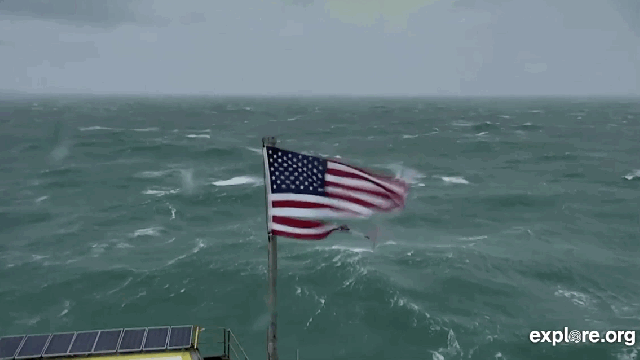With an ear-splitting howl and booming surf, Hurricane Florence has arrived. The storm could be a landmark event that breaks rainfall records, leaves waterways flooded for weeks, and reshapes the Carolinas coast for decades.
Florence is a super-sized, powerful Category 2 hurricane with tropical storm-force winds extending 314km out from its core. Because of its prodigious size, the storm has yet to make landfall, but its winds have neverthless whipped the ocean into a frenzy. Those winds can heard howling at the Frying Pan, a decommissioned lighthouse 55km off the North Carolina coast.
The surf and storm surge are already cutting through North Carolina’s Outer Banks and bands of rain are lashing the coast. Roads from the Outer Banks have been closed and ferries have stopped running as storm surge cuts across the islands, carving new inlets, stirring sea foam, and clawing at the foundations and stilts lifting homes above the normally tranquil beach.
Water surges over dunes and past homes on Hatteras Island #HurricaneFlorence
Hatteras cut off from mainland after N.C. 12 closure https://t.co/yhuTw4CNRN pic.twitter.com/96ZpjaTAwZ
— The Virginian-Pilot (@virginianpilot) September 13, 2018
Storm surge is the deadliest consequence of hurricanes and we’re already seeing some effects from Florence. Watch as an interior wall is ripped off a frame from a beach house near the coastline as captured by our field correspondents. pic.twitter.com/nc5MyC9ckN
— WeatherNation (@WeatherNation) September 13, 2018
It’s the start of what will be a hellacious few days as Florence moves ashore at a crawl and then cuts inland. Storm surge is expected to reach up to 4m, inundating coastal lowlands. That soggy ground also means that winds will have an easier time toppling power lines and leading to outages.
Paige Sheehan, a spokesperson for local utility Duke Energy, told us on Wednesday that the company had 20,000 workers at the ready to restore power, but that it was warning customers they could be without power for weeks.
“People who have spent their whole career here who have not seen an event like Florence,” she said.
States of emergency have been declared from Georgia to Maryland, underscoring just how wide Florence’s impacts could be. North and South Carolina as well as Virginia have ordered evacuations for coastal counties. The orders affect 1.5 million people, though some have chosen to ignore them.
The storm means business. Right now, the biggest issue with Florence is storm surge. Water pushed ashore by Florence’s winds is cutting through the barrier islands of the Outer Banks and slamming into the coast. The images are dramatic and the surge is only going to get worse as the storms moves ashore.
The surge is bad news, but even worse news is how long it could last. Florence’s slow movement means we could see days on end of high tides, hampering rescue efforts and increasing the risk of home being washed away.
Extra-tropical storm surge guidance suggests coastal #flooding over 7, maybe 8 high tide cycles, including this late AM’s high tide, perhaps through Sunday, if not Sunday night. Wow. #Florence pic.twitter.com/BY3kJ7qwKk
— Jonathan Erdman (@wxjerdman) September 13, 2018
Storm surge is one of the clearest climate change links when talking about Florence. Higher seas mean higher surge. But it’s an exclamation point on an unfolding disaster: Wilmington, North Carolina saw 84 days of floods on sunny days in 2016.
As of 6:00AM AEST, the hurricane force winds have arrived. A buoy near Wrightsville Beach (no tie to the Wright Brothers) recorded a gust of 122km/h, just a smidge over hurricane force. The graph below also shows air pressure dropping like crazy, an indicator that more powerful parts of the hurricane are coming ashore. And yet Florence’s eye is still well out to sea. Things are only going to get more wild from here.
We have our first hurricane force wind gust at the buoy off of Wrightsville Beach, NC. 66kts (76mph!) #Florence #NCwx pic.twitter.com/UuxHC8zZZU
— Ed Vallee ???? Vallee Wx Consulting ???? (@EdValleeWx) September 13, 2018
